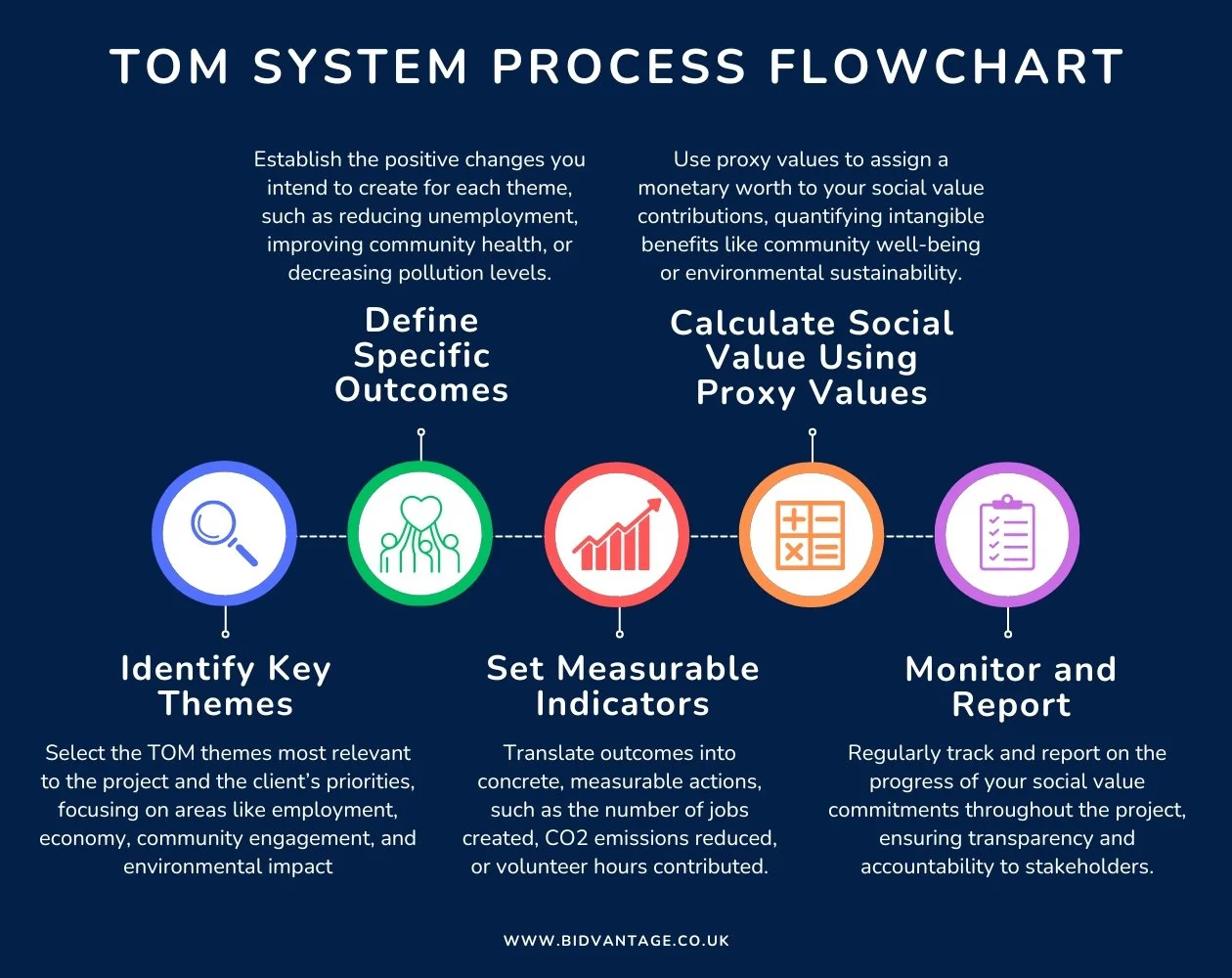Understanding Themes, Outcomes & Measures (TOM)
Demonstrating social value is a necessary component of bidding. The Social Value TOM (Themes, Outcomes, Measures) System is now the leading framework for organisations looking to deliver measurable social impact. This blog will explore how TOM works, its importance in bids and tenders, and practical strategies for leveraging it to secure bids.
What is the TOM System?
Demonstrating social value has become a critical requirement for tender success in bidding. This shift is largely driven by government policies such as the UK's Public Procurement Note (PPN) 06/21, which mandates that bidders show how their projects deliver positive social, economic, and environmental impacts. The Social Value TOM (Themes, Outcomes, Measures) System has emerged as the leading framework for organisations to measure and demonstrate these contributions, developed by The Social Value Portal.
The framework is built around four core themes:
Work: Providing employment opportunities.
Economy: Driving inclusive growth and supporting local businesses.
Community: Empowering communities and enhancing wellbeing.
Planet: Protecting the environment through sustainable practices.
The Role of TOM in Bidding
The TOM System is crucial in bidding, especially for public sector contracts. With social value now making up to 10% or more of the overall tender score in many procurement processes, a well-developed social value offer can significantly influence a bid’s outcome. TOM helps businesses align their social value strategies with the priorities of contracting authorities, showing exactly how they will create social, economic, and environmental benefits.
For example, a company bidding on a construction project could use TOM to demonstrate how it will:
Work: Create jobs for local unemployed individuals.
Economy: Source materials from small local businesses.
Community: Offer training programs to local youth.
Planet: Reduce the project's carbon footprint by using renewable energy.
Because the TOM System translates these contributions into monetary values—such as Social Value Pounds (SV£)—it gives contracting authorities a clear and consistent way to compare bids. It also enables businesses of all sizes, from small enterprises to large businesses, to showcase their social value contributions in a way that is standardised and easy to understand.
Best Practices for using TOM in Bidding
To fully leverage the TOM System in bidding, organisations should consider the following best practices:
Align Social Value with Contract Priorities: The social value offer in a bid should directly address the key priorities of the contract. This means carefully reviewing the procurement documents, especially the marketing criteria to identify what matters most to the buyer—whether it’s job creation, community development, or environmental protection—and tailoring your bid’s outcomes and measures accordingly.
Customise Your Outcomes and Measures: Whilst the TOM System provides a standard framework, it’s important to customise it for each bid. Demonstrate how your project’s specific outcomes and measures will meet the client’s objectives. For instance, if the project is in a low-income area, you might want to emphasise local job creation and youth training programs.
Back-Up Your Claims with Evidence: Provide data from past projects to support your social value claims. Whether it’s data on the number of jobs created or metrics on environmental impact, credible evidence strengthens your bid. Buyers want to see that your promises are realistic and based on past performance or thorough planning.
Be Realistic in Your Promises: Overpromising can be a common error in bidding. Whilst it may seem tempting to pledge ambitious social value contributions, it’s vital to ensure that you can deliver on each promise. Contracting authorities look for achievable and sustainable outcomes, and not delivering on commitments can damage future opportunities.
Make Social Value Central to Your Operations: Successful bidders integrate social value into their core business activities. Social value should not be an afterthought but a fundamental part of your project delivery. Demonstrating that social value is embedded in your business model not only strengthens your bid but also enhances your credibility in future tenders.
Practical Steps for Implementation
Implementing the TOM System requires clear planning, tracking, and reporting. Here are some practical steps for incorporating TOM into your business strategy:
Understand the Themes and Their Relevance: Begin by familiarising yourself with the four TOM themes—Work, Economy, Community, and Planet. Each project will emphasise different themes based on its scope and the buyer’s priorities. Identify which themes are most relevant to the contract and focus on delivering strong outcomes in those areas.
Set Achievable Outcomes: Define the outcomes you aim to achieve, ensuring they align with the priorities of the tender. For example, if you’re working on a construction project, focus on creating local employment or reducing environmental impact by adopting sustainable building practices.
Quantify Measures Using Proxy Values: One of TOM’s strengths is its ability to quantify social value using proxy values. These values assign monetary worth to social actions—like improving community health or reducing CO2 emissions—making it easier to demonstrate the financial impact of your project. Ensure that you are familiar with how these proxy values work and apply them to the outcomes in your bid.
Monitor Progress and Report: Set up systems to track the delivery of your social value commitments. Contractors expect transparency, so regularly report on your progress throughout the project lifecycle. Use measurable data to showcase your impact, such as the number of jobs created, or CO2 reductions achieved.
By taking these steps, organisations can confidently apply the TOM System to not only meet social value requirements but exceed them, thereby increasing their chances of winning bids.
Conclusion
The Social Value TOM System offers a clear, standardised way for businesses to demonstrate the positive impact they can deliver through public and private sector projects. By understanding and applying TOM’s framework—focusing on themes, outcomes, and measures—organisations can showcase their ability to create tangible social value, making their bids more attractive to buyers. In a competitive bidding environment, where social value is often a key differentiator, effectively leveraging the TOM System can be the key to success.
If you’d like to learn more about TOMs, visit the Social Value Portal website here.


